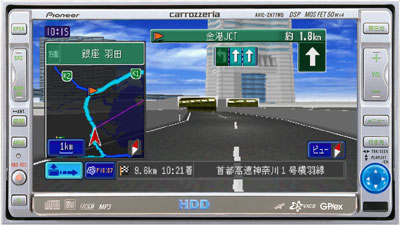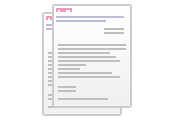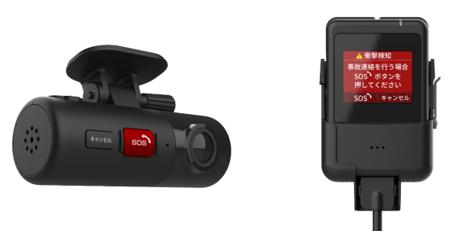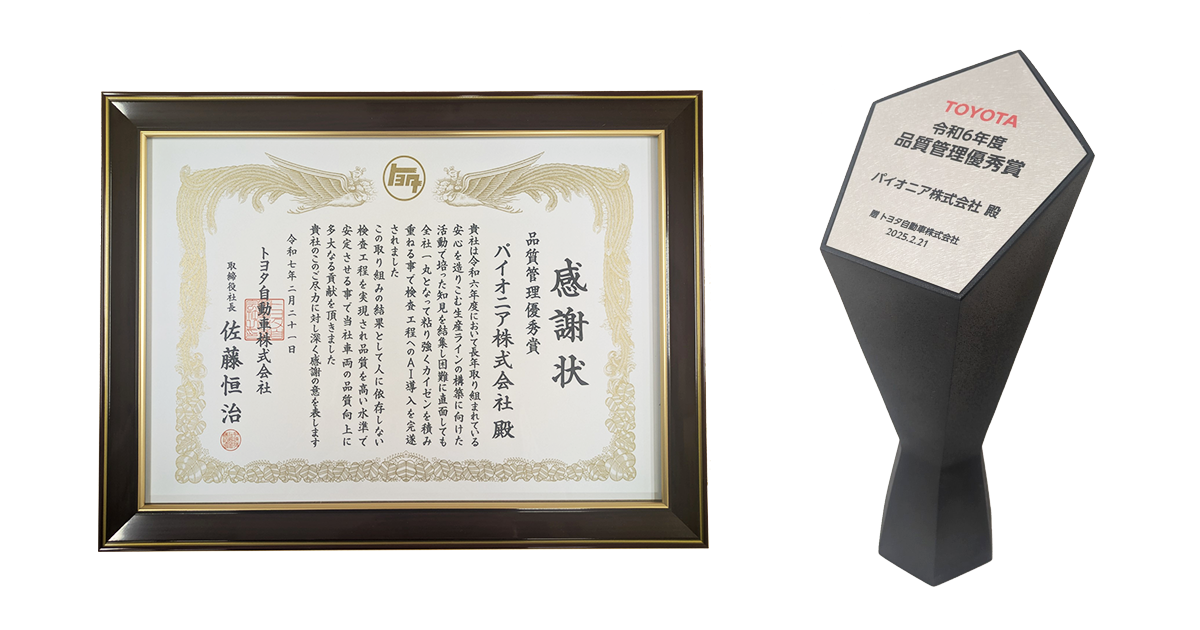News Releaseï¼ڑPioneer Releases the New Line of Hard Disk-based"CYBER NAVI" Car Navigation Systems
Information contained in the news release is current as of the date of announcement.
It is subject to change without prior notice.
Pioneer Corporation
Pioneer Releases the New Line of Hard Disk-based
"CYBER NAVI" Car Navigation Systems
May 8th, 2002, Tokyo, Japan - Pioneer Corporation (NYSE: PIO) today announced its new line of car navigation systems for the release in Japan in late May, branded as "Carrozzeria". A 2-DIN single-unit A/V Navigation Server, the AVIC-ZH77MD has been added to the new line for attaining further merges of car navigation systems and audio systems, enriching the world of Hard Disk-based "CYBER NAVI" Car Navigation series.

AVIC-ZH77MD
< Hard Disk "CYBER NAVI" Car Navigation Server >
| Product | Model Name | S.R.P. in Japan (excl.tax) | Availability | Monthly Production |
| Hard Disk-based Navigation Server with built-in DVD/CD unit | AVIC-H99 | ¥210,000 | late May | 5,000 units |
| 2-DIN single-unit A/V Navigation Server with wide 6.5-inch TV/MD/CD·HDD·DSP | AVIC-ZH77MD | ¥315,000 | late May | 6,000 units |
| Hard Disk-based Navigation Server Set with wide 7.0-inch TV, and built-in DVD/CD | AVIC-XH99 | ¥315,000 | late May | 2,500 units |
| Hard Disk Navigation Server Set with wide 7.0-inch TV, and built-in CD unit | AVIC-XH77 | ¥278,000 | late May | 2,000 units |
< TV / Monitors>
| Product | Model Name | S.R.P. in Japan (excl.tax) | Availability |
| A/V Power Unit with wide 7.0-inch TV / MD·DSP | AVIC-V77MD | ¥165,000 | late May |
| A/V Power Unit with wide 7.0-inch TV and DSP | AVIC-V77 | ¥140,000 | late May |
| Wide 8.0-inch LCD TV Pack | TV-W88 | ¥136,000 | late May |
< Option >
| Product | Model Name | S.R.P. in Japan (excl.tax) | Availability |
| ETC (Electronics Toll Collection) Unit | ND-ETC2 | ¥42,000 | late May |
<< Background >>
Last year, Pioneer introduced in Japan its car navigation systems that adopted a hard disk as the medium to store map data. The hard disk's high memory storage capacity, high-speed access, and rewritable capability not only upgraded the performance of the car navigation systems but also enabled the addition of extra features such as a music server function, an industry's first. As a result, Pioneer's hard disk-based car navigation systems received high accolades from the customers, establishing a solid leading position in the Japanese marketplace.
Pioneer's new line of car navigation systems taps the potential of hard disks even further by adding a 2-DIN single-unit A/V navigation server, the AVIC-ZH77MD that further merges car navigation and in-car A/V pleasures.
By maximizing the advantage of the hard disk's rewritable capability, a user can now personalize the functions of the car navigation systems. With this unique new function and conventional high performances, Pioneer's new hard disk-based "CYBER NAVI" series has evolved into a device that makes driving easier and more enjoyable than ever.
<< Main Features of the Car Navigation System Main Unit (Hardware)>>
Hard Disk-based Navigation Server: AVIC-H99, AVIC-XH99, AVIC-XH77
1 ) All the basic hardware needed for navigation is housed in a single 1-DIN unit.
A single 1-DIN* unit is equipped with all the basic hardware required for navigation, including 3D gyro sensor, FM multiplex tuner, PC card slot, DVD-Video/CD player (AVIC-H99, AVIC-XH99) or CD player (AVIC-XH77), and 2 hard disk drive slots (one already fitted).
2 ) IQ Precision-positioning accuracy of the highest standard in the industry-has been further improved.
Greater positioning accuracy has been achieved by incorporating a Crystal 3D Hybrid Sensor and improving constituent technologies used in various areas. In addition, the new Urban Expressway Lane Recognition function that imparts a completely new sense of positioning accuracy has been added, demonstrating the new direction of IQ Precision.
3 ) Hardware for realizing state-of-the-art functions is built into the main unit.
- Voice Recognition functions for easy, safer operation and a variety of communications functions are built in.
- Supports ETC (Electronic Toll Collection) and HELPNET (emergency calling system) with the connection of optionally available units.
- Includes a PC Card Slot for external data communications.
2-DIN single-unit A/V Navigation Server with wide 6.5-inch TV/MD/CDمƒ»HDDمƒ»DSP: AVIC-ZH77MD
1 ) High-performance, full-function hard disk navigation and versatile A/V features in a 2-DIN single unit
In addition to the 3D Hybrid Sensor used for car navigation and a VICS (Vehicle Information and Communication Systems) FM multiplex tuner, this model contains a hard disk to provide an enjoyable audio environment, a MOS FET 50W x 4 amp, CD player, MD player, wide 6.5-inch TV, FM/AM tuner, and a PC card slot. For use as a music server, the large-capacity 16GB hard disk drive can record up to about 100 CDs (calculated at 60 min. each). The compact unit fits snugly into the console of the car and its luxury design enhances the interior decor.
2 ) Touch panel ensures quick, intuitive operation.
The touch panel of the wide 6.5-inch LCD allows quick, intuitive operation of the car navigation and audio functions. The touch panel is a film/glass type with a resistive pressure-sensitive screen coated with an anti-glare material which suppresses the reflection of external light while raising the brightness of the screen. The anti-glare coating also effectively protects the touch panel from becoming soiled by fingers during operation.
A/V Power Unit with wide 7.0-inch TV: AVIC-V77MD, AVIC-V77
1 ) Combines with the AVIC-H99 to become an A/V Navigation Server.
When the AVIC-V77MD/V77 is combined with the AVIC-H99, the same user interface can be used to control all functions from audio to car navigation.
Note: The AVIC-V77MD/V77 cannot be used as stand-alone products.
2 ) Combines with the AVIC-H99 for the enhancement of functionality.
In addition to the "P side P display (Side-by-Side Picture Display)" split screen feature with car navigation on one side and TV viewing on the other, this combination also supports the "P in P display (Picture-in-Picture)" screen display. Broadcast stations are also easier to select, since not only broadcast station names but also the actual TV images being received can be shown in 12 split screens or 12 split screens plus the navigation screen.
Wide 8.0-inch LCD TV Pack: TV-W88
1 ) Wide 8.0-inch LCD TV delivers vivid, high picture quality.
The wide 8.0-inch LCD screen, the largest in the industry, displays car navigation and TV images in vivid, high picture quality.
2 ) Functionality is enhanced when combined with the AVIC-H99.
- In addition to the "P side P display (Side-by-Side Picture Display) split screen feature with car navigation on one side and TV viewing on the other, this combination also supports the "P in P display" (Picture-in-Picture) screen display.
- Broadcast stations are easier to select, since not only broadcast station names but also the actual TV images being received can be shown in 12 split screens or 12 split screens plus the navigation screen.
<< Upgraded Hard Disk-based "CYBER NAVI" Adds New Capabilities >>
1 ) Personalization: the hard disk opens new directions for car navigation.
- "Route Advisor" proposes new routes based on stored information about routes already traveled.
The Route Advisor function proposes new routes based on information such as detours traveled in the past using Auto Reroute and pre-registered routes. Routes that the driver has stored thus far, such as roads that were often used and shortcuts that had been traveled are proposed in advance by the car navigation system. Since the system also compares differences in time and distance between old and new routes, the driver can check them via screen displays and voiced advice to choose the route best suited for the current trip. - "Drive Scheduler" automatically activates the set activities
A new interface between the driver and car navigation, the Drive Scheduler, allows the user to program the system to activate the system's various functions at preset times and locations.
- Destination Reservation reserves in advance the route to where the driver wants to go.
- Area Search Reservation searches for parking locations in the area of the destination.
- Reminder Reservation informs the driver about important things.
- Source Reservation turns on the TV or radio when time comes for the programs the driver wants to enjoy.
- Car Maintenance function notifies the driver when various aspects of car maintenance come due.
- "Landmark Rewrite" allows landmark data to be revised as needed.
The rewriteable capability of the hard disk is taken to maximum advantage by the Landmark Rewrite function that lets drivers add, move, or delete landmarks such as gas stations, restaurants, stores and other facilities shown on the map. Changes are reflected in area searches and landmark displays. A PC card can also be used to exchange data with an external device. - "My List Search" lets users download complete sets of up-to-date information about certain spots.
Users can connect their mobile phone and download the most up-to-date information via the Internet from dedicated servers. This information which is typically difficult to obtain from a fixed database can be easily downloaded and stored onto the hard disk as a personalized search list to further expand the pleasures of driving. Categories of fresh information that can be searched include: "Recommended Content", which provides information that is updated weekly; "Content by Area", which provides recommendations for individual areas; and "Seasonal Information", which provides information on flower viewing and other activities specific to the season. - "Wallpaper Customization" lets users customize the background pattern of the operation or audio screen.
A favorite photo taken with a digital camera or other image can be used as the background pattern for the car navigation operation screen or audio screen. There is also a "Play List Image Link" function that lets users link the images with music according to the play list on the music server. Background patterns that match the music being played can be used. - "Continuous Speaker Learning" function provides greater flexibility in voice-based operation.
The Continuous Speaker Learning function learns the voice qualities of the driver each time he or she uses voice-based operation, improving the system's recognition rate of the speaker. This enhanced voice recognition capability makes voice-based operation much easier than before, providing safe, comfortable driving.
2 ) Map displays balance aesthetics and practical capabilities
- "City Highway Map" makes maximum use of remarkable drawing capabilities and high positioning accuracy.
The "City Highway Map", inherited from the successful models of last year, not only depict complex urban expressway routes with high visual reality but now even competently guide drivers through confusing lane changes. Besides depicting the traffic lanes, 3D intersections, and buildings along the route, the addition of an "Auto Angle Change" function improves navigation through urban expressway networks by enabling drivers to see full views of junctions. Since the navigation system recognizes the lane in which the car is traveling (using the Urban Expressway Lane Recognition feature), the "Lane Change Advisory Display" function can prompt drivers about lane changes when needed. - Improved "Driver's View".
The map display depicted from the driver's viewing angle has been further improved. The main intersections of Tokyo, Osaka and Nagoya are provided in 3D, enabling drivers to navigate through the maze of city streets more easily.
3 ) Practical functions support hassle-free driving.
- "Urban Expressway Illustrated Display" makes driving on urban expressways even easier.
When the driver approaches ramps or junctions along urban expressways, "Junction Illustrated Display" shows recommended lanes and the direction of the junctions, and "Entrance Illustrated Display" shows difficult-to-find entrances to urban expressways, to make driving on urban expressways less complicated. All the ramps and junctions of urban expressways in Japan can be viewed using Urban Expressway Illustrated Display. - "Landmark Guide" uses voice to alert the driver to landmarks at certain spots.
Landmarks are highlighted on enlarged maps of intersections while voiced guidance leads the driver in the right direction. - "Congestion Check" has been improved to give the driver easier access to needed information on traffic conditions.
By simply pressing the "Congestion Check" button, the driver can check information on traffic congestion for up to five locations along the established route starting with the location nearest ahead. The current map and the map showing the locations of congestion are shown side-by-side in two screens, and voiced guidance informs the driver in advance about the length of the congestion and how long it would take to pass through it. - "Congestion Auto Detour" enables comparisons between the original route and alternate routes to avoid the congestion.
In the event of congestion along the established route, "Congestion Auto Detour" automatically proposes detours around the congestion and displays differences in distance, time, and toll fares compared to the original route. The driver can select a detour based on these comparisons.
Note: the Beacon Receiver for VICS, the ND-B4 is necessary, which is already available as an option. - "Route-side Area Search" searches for facilities along the route where the driver can stop off.
The driver can make searches limited to along the route for places to make stop-offs. - More complete collection of recorded data
Covered areas for the 1,406 cities recorded have been expanded; about 30 million addresses can be searched; and about 61,000 direction signs from all over Japan and expressway lane information for about 53,500 locations have been recorded.
4 ) Network functions enable external data communications
- "Live Weekly Weather Forecasts".
Besides ordinary weather reports, weather forecasts for the coming week can also be downloaded. Advance information about weather at travel destinations is helpful for making driving plans. - "Card Communications & Digital Camera Links" enable data retrieval and exchanges using PC cards.
Registered data can be saved on a PC card; images and data on registered locations and roads within a PC card can be imported to the system; and photos taken with a digital camera can also be stored and used as background patterns for menu screens.
5 ) User-friendly interface attained by quick response operation.
- "Touch Panel Operation" makes the 2-DIN single unit A/V car navigation server easy to operate.
All functions of the AVIC-ZH77MD, from car navigation to audio, can be operated very easily on the unit's touch panel screen. The features of touch panel technology have been taken to maximum advantage, providing easy-to-locate buttons and quick-response operation. - "Operation Navigator" makes multiple functions easy to use.
The "Operation Navigator" not only provides help in times of trouble but also explains how to operate the many convenient functions of the hard disk-based "CYBER NAVI" system, from basic operation to applications, on the screen and by voice in easy-to-understand language. - "Direct Search & Operation" further improves voiced operation.
In the past, a voiced command to establish a route to a destination required two stages, such as "Tokyo Station" followed by "Go there." With the new hard disk-based "CYBER NAVI" however, only one phrase, "Go to Tokyo Station," is all that is needed, making voiced operation considerably simpler.
6 ) "Music Server" takes the convergence of audio and car navigation to a higher dimension.
- "Direct Track Title Specification" starts play of a favorite track title following a simple voiced operation.
Any track in the music server library on the built-in hard disk can be played by simply speaking the track's title. A list of titles can be also displayed on the audio screen in case the name of a track's title needs to be checked first. - "MP3 Playback" plays music data from an external source.
MP3 Playback improves audio life in the car by playing not only music recorded on the built-in hard disk but also MP3 files created on a computer and recorded onto a PC card or a CD-R/RW disc.
Note: MP3 files on a PC card or CD-R/RW disc cannot be recorded onto the built-in hard disk.
ETC (Electronic Toll Collection) Unit: ND-ETC2
Pioneer updated the ND-ETC1 to conform to the new Radio Wave Law that came into effect on April 1, 2002. The function designed to prevent users from leaving cards inserted in the device was added, and the supplied power cable was extended from 2 to 4 meters.
Search for Other resources
Search for Keyword
Search by date
-
December 12, 2025Research and developmentPioneer Develops AI Agent for Next-Level in-vehicle infotainment (IVI) with Microsoft Foundry
AI and cloud solutions combine to bring innovative UX and greater safety to a variety of vehicles
-
December 1, 2025ManagementPioneer Announces Completion of Shareholder Transition

-
November 27, 2025EventsPioneer to Showcase Industry-leading Solutions for SDVs and Two-Wheelers at CES 2026 in Las Vegas

-
July 14, 2025ProductsPioneer to Supply Network-Connected Dash Cams to Tokio Marine & Nichido Fire Insurance for Its New Optional Auto Insurance Plan
Providing drivers with prompt and dependable post-incident assistance aided by recorded driving data and video footage
-
June 26, 2025ManagementAnnouncement of Shareholder Change

-
May 29, 2025OtherPioneer’s GHG Emissions Reduction Targets Approved by SBTi

-
May 9, 2025ManagementPioneer Announces Executive Appointments

-
April 1, 2025ManagementPioneer Appoints Werner Koestler as Executive Fellow
as Part of Driving Growth of Its Business in Global Markets
-
March 28, 2025ManagementPioneer to Begin Manufacturing In-Car Products in India
A strategic initiative to better serve local automakers
and drive the growth of its global business
-
March 25, 2025OtherPioneer Recognized by Toyota Motor for Stringent Quality Management for Second Consecutive Year
Upgraded stress-free production process helps keep the quality of Toyota and Lexus cars
at the highest level
